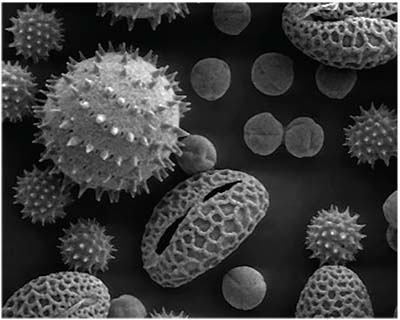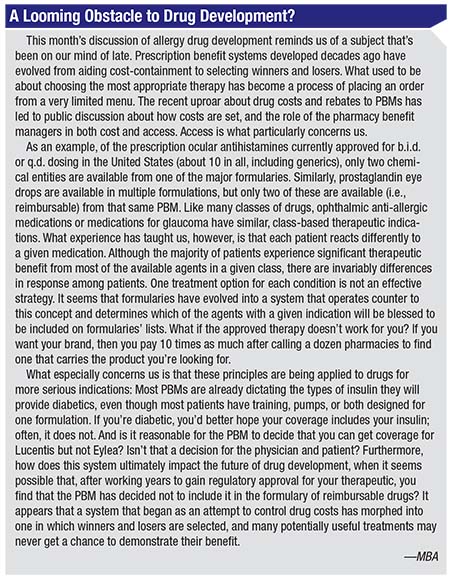 |
| The seasonal allergen pollen. |
Identifying Targets
In immune reactions such as allergic conjunctivitis, there is a series of cellular events, including sensitization to the allergen, presentation by dendritic cells and priming of naïve T cells that collectively lead to production of IgE-producing B cells.2 Upon subsequent exposure, the complex of antigen, IgE and immunoglobulin receptors will cross-link on conjunctival mast cells, causing degranulation and release of histamine and other pro-inflammatory factors. In the continued presence of antigen, this immediate hypersensitivity can lead to a late-phase response (typically hours later) in which other immune cells, particularly neutrophils and basophils, are recruited to infiltrate into the conjunctiva. This T helper-2-type response is an inappropriate activation of the immune system. The process is not a single event; rather, it is a signaling cascade that presents multiple potential targets. Although there is a wealth of basic science that identifies possible points of therapeutic intervention, significant work remains before isolating the key step for disease modification.
One of the most attractive sites for new drug targeting is spleen tyrosine kinase (Syk).3 Syk-catalyzed phosphorylation mediates interactions between the Fcε receptors and their downstream targets, and Syk is one of several kinases implicated in this allergic cascade. (See the May 2013 Therapeutic Topics for details.) Syk inhibitors have been touted as potential therapies for leukemias and lymphomas, for autoimmune and allergic asthma conditions, and for allergies.4 There are a number of small molecule Syk-targeted compounds in clinical-stage testing, and trials involving allergic disorders are likely in the near future.
Like Syk, other kinase inhibitors have the potential to be useful therapies for ocular allergy. A recently published study found the long sought after bridge between mast cells and asthma by demonstrating the positive effects of imatinib (Gleevec, Novartis), a kinase inhibitor currently approved for treatment of chronic myeloid leukemias and stromal tumors.5-7 This drug inhibits multiple kinases, including a key mast cell growth regulatory kinase called KIT; in patients with refractory asthma, it increased airway hyper-responsiveness and reduced mast cell numbers. While the adverse effects of imatinib may preclude its use for AC, this does provide a clear proof of principle in the use of KIT inhibition as a tool to address mast cell-mediated disorders.
Another kinase in the crosshairs is IkK-β, a component in the NFκB gene regulatory pathway.8 This pathway is responsible for upregulation of pro-inflammatory signaling molecules. And under resting conditions it’s kept silent by the action of the Ik-β, a protein that stabilizes the inactive complex. When phosphorylated by IkK-β, it is released from the complex, which allows activation of its gene-regulating function. Inhibitors of this kinase share some of the functional transcriptional suppression action elicited by corticosteroids. Experimental compounds such as SAR113945 (Sanofi) have been tested as treatments for osteoarthritis,9 and similar compounds may have a role in chronic allergy therapy.
We can’t leave a discussion of repurposing kinase inhibitors without mentioning two important kinase families, the ROCK kinases and the MAP kinases. Both are targets of therapies in a host of different disorders, from glaucoma to various neoplasias. Compounds focused on these molecular targets are best suited to an empirical assessment of efficacy in ocular allergy and inflammation. The benefit of the eye as a target is the simplicity of access and of rapid and reliable assessment of response.
On a different front, efforts to unravel the mechanisms of action for several compounds derived from natural products used as allergy treatments (such as flavonoids, stilbenes and curcuminoids)10 have narrowed the focus to a common mast cell stabilization effect, as demonstrated by in vitro studies in basophilic cell lines.11 Given the apparently common mechanism in several disparate herbal preparations, interest in mast cell stabilizers may be on the horizon.
The State of Immunotherapy
One of the most anticipated therapeutic arrivals in ocular allergy treatments of late came in 2013 and 2014, with approvals of sublingual timothy grass antigen extracts as a desensitizing approach to seasonal allergies.12,13 These approvals received a first-ever FDA indication for “allergic rhinitis with or without conjunctivitis,” opening the door to future treatments for rhino-conjunctivitis. This treatment approach, in which continuous exposure to low-level allergen leads to a switch from the pro-inflammatory Th2 to the anti-inflammatory Th1 profile, is designed to reduce and, ultimately, extinguish the allergen
 |
After a little less than three years on the market, it appears that primary competition for these new therapies wasn’t oral or topical anti-allergic medications, but the injection protocols allergists have been using for many years to achieve the same desensitized endpoint. Sales of Grastek (Merck) and Oralair (Stallergenes) have been much less than anticipated, and Merck returned product marketing rights to its development partner, ALK-Abello, in July 2016. Despite this, another Merck/ALK-Abello immunotherapy targeted against the perennial allergen the dust mite14 was approved by the FDA in March 2017. It will be interesting to see how those with perennial allergies respond to the availability of this new therapy, and whether long-term efficacy can generate a market that has not been seen with the seasonal allergic immunotherapy treatments.
This is where we stand in 2017: a list of potential compounds with intriguing anti-inflammatory effects highlighted by a long list of kinase inhibitors with the potential for successful repurposing. Of course there are other compounds at earlier stages of development that constitute the future of allergy therapeutic progress, where a steady flow of test compounds will be gauged for their ability to meet the high bar that has been established. There is still much progress to make in refining and optimizing drugs, but we have the benefit of a solid base of therapeutic options that makes it possible to reach for the very best of new treatments. REVIEW
Dr. Abelson is a clinical professor of ophthalmology at Harvard Medical School. Mr. Gomes is vice president of allergy at the pharmaceutical consulting firm Ora. Dr. Hollander is chief medical officer at Ora, and assistant clinical professor of ophthalmology at the Jules Stein Eye Institute at the University of California, Los Angeles.
1. Gomes PJ. Trends in prevalence and treatment of ocular allergy. Curr Opin Allergy Clin Immunol 2014;14:5:451-6.
2. Abelson MB, Shetty S, Korchak M, Butrus SI, Smith LM. Advances in pharmacotherapy for allergic conjunctivitis. Expert Opin Pharmacother 2015;16:8:1219-31.
3. Lucas MC, Tan SL. Small-molecule inhibitors of spleen tyrosine kinase as therapeutic agents for immune disorders: Will promise meet expectations? Future Med Chem 2014;6:16:1811-27.
4. Ramis I, Otal R, Carreño C, et al. A novel inhaled Syk inhibitor blocks mast cell degranulation and early asthmatic response. Pharmacol Res 2015;99:116-24.
5.https://www.accessdata.fda.gov/drugsatfda_docs/label/2017/021588s049lbl.pdf. Accessed 26 May 2017.
6. Cahill KN, Katz HR, Cui J, et al. KIT inhibition by imatinib in patients with severe refractory asthma. N Engl J Med 2017;376: 1911-20.
7. Galli SJ. Mast cells and KIT as potential therapeutic targets in severe asthma. N Engl J Med. 2017;376:20:1983-1984.
8. Miyazaki D, Mihara S, Inata K, et al. Pharmacologic inhibition of IκB kinase activates immediate hypersensitivity reactions in mice. Am J Pathol 2013;183:1:96-107.
9. Matsuda H, Nakamura S, Yoshikawa M. Degranulation inhibitors from medicinal plants in antigen-stimulated rat basophilic leukemia (RBL-2H3) cells. Chem Pharm Bull (Tokyo). 2016;64:2:96-103.
10. Yoo G, Lee K, Lee DC. Inhibitory effects of 2-oxo-2H-chromen-4-yl 4-methylbenzenesulfonate on allergic inflammatory responses in rat basophilic leukemia cells. Int Immunopharmacol 2017;48:196-202.
11. Fujita H. Soyka MB, Akdis M, Akdis CA. Mechanisms of allergen-specific immunotherapy. Clin Transl Allergy 2012;2:2.
12. Maloney J, Bernstein 01, Nelson H, el al. Efficacy and safety of grass sublingual immunotherapy tablet MK-7243: A large randomized controlled trial. Ann Allergy Asthma lmmunol 2014;11:2:146-153.
13. Creticos PS, Maloney J, Bernstein DI, et al. Randomized controlled trial of a ragweed allergy immunotherapy tablet in North American and European adults. J Allergy Clin lmmunol 2013; 131:1342-1349.
14. https://www.fda.gov/downloads/biologicsbloodvaccines/allergenics/ucm544382.pdf. Accessed 26 May 2017.



